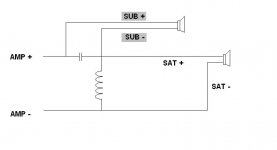This crossover is part of an old subwoofer I have. I don't know what type it would be called. I have a rudimentary understanding of crossovers. I understand first and second order parts; basically. This thing appears to be a second order crossover, but the components are shared between the two driver setups?
My first order understanding is, for instance, a capacitor in series with a driver to form a hi-pass filter. Put a coil in parallel and you have a second order filter. Change the values and you change the crossover frequency. Change the positions of the cap/coil for a low-pass filter. Fine. But I've only seen caps/coils wired as two components into low/high filters; a cap/coil for a hi-pass circuit and a coil/cap for a lo-pass circuit.
What do you call ONE cap/coil pair wired to be BOTH a high and lo-pass filter?
This question may well fall below the threshold of the bottom of the simple box. I don't mind admitting that. I would appreciate some simple input, though. Maybe it would work just fine. It did operate for years...meaning an amp was hooked up to it and sound came out. I'd just like to know what, in fact, the circuit accomplishes.
Thanks for the learnin'!
A bit of clarification: Where a line touches/intersects, there is a connection.
My first order understanding is, for instance, a capacitor in series with a driver to form a hi-pass filter. Put a coil in parallel and you have a second order filter. Change the values and you change the crossover frequency. Change the positions of the cap/coil for a low-pass filter. Fine. But I've only seen caps/coils wired as two components into low/high filters; a cap/coil for a hi-pass circuit and a coil/cap for a lo-pass circuit.
What do you call ONE cap/coil pair wired to be BOTH a high and lo-pass filter?
This question may well fall below the threshold of the bottom of the simple box. I don't mind admitting that. I would appreciate some simple input, though. Maybe it would work just fine. It did operate for years...meaning an amp was hooked up to it and sound came out. I'd just like to know what, in fact, the circuit accomplishes.
Thanks for the learnin'!
A bit of clarification: Where a line touches/intersects, there is a connection.
Attachments
Last edited:
It is a series 1st order xover, for more info see here:
Series vs. Parallel Crossover Networks
The interesting peculiarity of this kind of filters is that if you run them without drivers attached, your amp may blow up; at the resonant frequency of the LC, a short occurs; the amp will only see the Rdc of the coil plus the ESR of the cap as a load.
Series vs. Parallel Crossover Networks
The interesting peculiarity of this kind of filters is that if you run them without drivers attached, your amp may blow up; at the resonant frequency of the LC, a short occurs; the amp will only see the Rdc of the coil plus the ESR of the cap as a load.
The way it is drawn it is not even possible to determine whether it is a parallel or a series 1st order crossover.
Put the dots where they belong to and we have an unambiguous situation. 😉
Regards
Charles
Put the dots where they belong to and we have an unambiguous situation. 😉
Regards
Charles
It is a series 1st order xover, for more info see here:
Series vs. Parallel Crossover Networks
The interesting peculiarity of this kind of filters is that if you run them without drivers attached, your amp may blow up; at the resonant frequency of the LC, a short occurs; the amp will only see the Rdc of the coil plus the ESR of the cap as a load.
That fits perfectly! Of course it does, because it is the fact of the matter.
Thank you! When searching crossover designs, all I ever found (and I looked a good bit) was the parallel type. Never did see the series type mentioned; didn't use the 'right' search words for that type to have come up, evidently.
Isn't everything simple when you know how to do it!
I was hesitant to ask the question, knowing the answer HAD to be simple. I would rather not show my ignorance if I can find the answer myself. BUT...that wasn't happening.
Thank you for taking the time for such basic (evidently) education. I appreciate it.
This was cleared up in #1.
OK now it is clear ! Yes, definitley a classic 1st order series crossover. The funny thing is that it would be transformed into a parallel one just by opening one connection, the way itis drawn.
Regards
Charles
- Status
- Not open for further replies.
